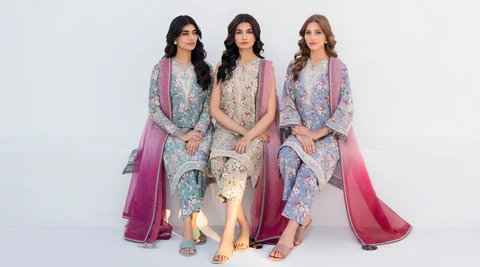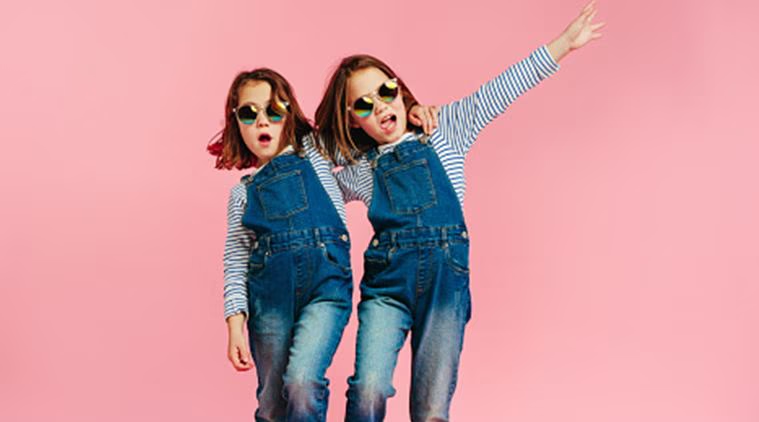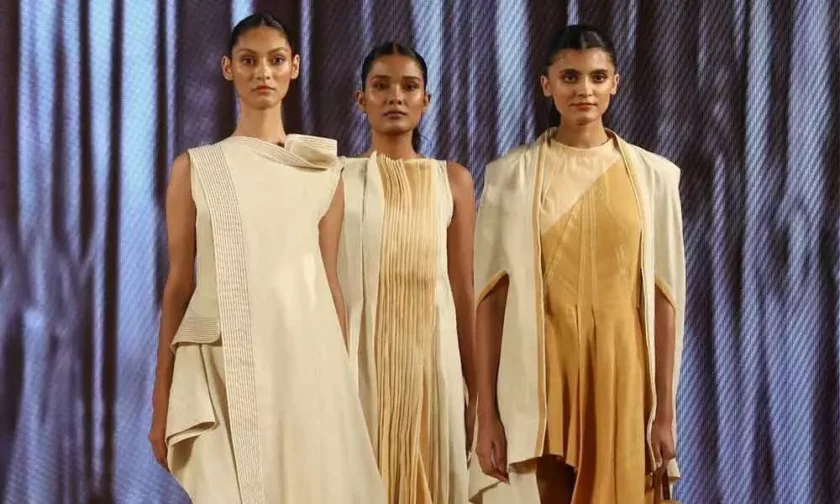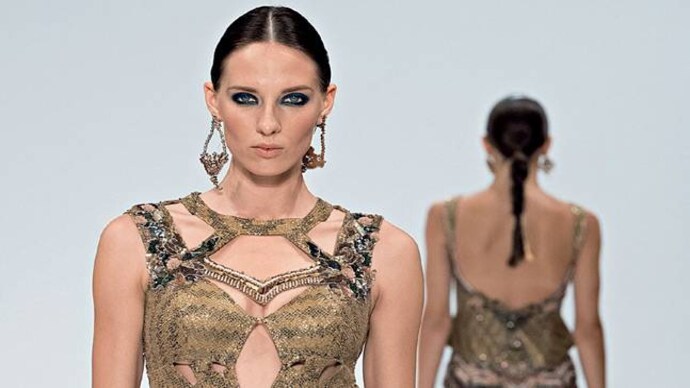Lucknow: Lucknow, the City of Nawabs, is a living testament to opulence where history and haute couture entwine along its bustling streets. Renowned for Chikankari—the delicate white-on-white embroidery adorning mulmul fabrics—and Zardozi’s shimmering gold and silver threads, the city’s fashion scene embodies Mughal grandeur. These crafts, nurtured in the 17th century under Empress Nur Jahan’s patronage, symbolize refined simplicity and regal splendor. As Paola Manfredi notes in Chikankari: A Lucknawi Tradition, “Chikankari is one of the finest traditional embroideries of India, a symbol of Lucknawi culture and elegant courts of the nawabs of Awadh.”
Today, Lucknow’s streets pulse with this legacy, drawing global shoppers to markets like Hazratganj and Chowk. Amid the aroma of kebabs and the chatter of haggling, these lanes offer not just garments, but stories stitched into silk and cotton—eternal emblems of Awadhi grace.
Hazratganj: The Heartbeat of Modern Nawabi Chic
At the center of Lucknow’s fashion frenzy lies Hazratganj, a colonial-era boulevard transformed into a shopper’s paradise since 1810. Flanked by arched walkways and colonial facades, this mile-long stretch buzzes with boutiques blending traditional Chikankari kurtas with contemporary fusion wear.
Stores like Ada Chikan showcase ethereal georgette anarkalis embroidered with jaali work, while Janpath Market—tucked within the precincts—offers affordable ethnic ensembles. “Hazratganj is often referred to as the shopping paradise of Lucknow,” enthuses a guide from WeddingKalakar, “home to high-end stores and branded showrooms housing some of the best Chikankari boutiques.”
Here, Zardozi lehengas catch the light like jewels from a nawab’s treasury, their intricate badla threads evoking the opulence of Bara Imambara. Youngsters flock to ‘ganjing’—the local term for leisurely strolling—picking up fusion palazzos or pearl-embellished dupattas. Evening bazaars light up with fairy lights, turning the street into a runway where history meets high street. Prices range from ₹500 for a simple kurti to ₹50,000 for bespoke bridal wear, making the experience accessible yet aspirational.
A local artisan reflects, “These streets breathe the Nawabi andaaz—elegant, unhurried, and utterly timeless.” Hazratganj isn’t just shopping; it’s a sensory symphony of silk rustles and silver gleams, where tradition and modernity coalesce effortlessly.
Aminabad and Chowk: Timeless Lanes of Artisan Alchemy
Venturing into Lucknow’s old quarters reveals Aminabad and Chowk, labyrinthine bazaars where the soul of Chikankari thrives. Aminabad, dating to the 18th century, is a riot of narrow alleys teeming with over 5,000 shops. Known as the “garments district,” it is a haven for Zardozi saris and hand-embroidered salwar suits sourced directly from Uttar Pradesh’s weaving hubs. Bargaining here is an art—start at half the quoted price for a mulmul kurta with delicate tepchi stitches.
Nearby, Chowk hums with workshops where karigars hunch over wooden frames, their needles dancing floral motifs onto chiffon. “Chowk is the most famous market in Lucknow for pretty Chikankari kurtis and kurtas,” notes All About Eve, highlighting its street-side tailors who craft custom pieces. Zardozi enthusiasts flock to Nakhas Market, a 200-year-old enclave where gold-threaded sherwanis whisper tales of royal durbars.
The air is thick with fragrances—ittars, spices, and incense—while street vendors offer malai gilori and kebabs. “In the busy streets of the ‘City of Nawabs’, there’s a timeless story that continues to unfold, woven into delicate fabrics with even more delicate hands,” observes Times of India. These streets preserve the craft’s purity: 36 stitches, including bakhiya and hool, ensure every garment carries generations of skill, far from machine-made imitations.
Janpath and Nakhas: Fusion Flavors and Heritage Heirlooms
For a youthful twist, Janpath Bazaar pulses with contemporary Chikankari—think organza tops fused with gota patti, mirror-work kurtas, and ethnic ensembles for the urban elite. This Hazratganj offshoot caters to Gen Z with woolens, belts, and ethnic fusion at bargain rates. Its vibrant stalls offer a sharp contrast to the sedate nawabi courts yet remain infused with their spirit. “Janpath Bazaar is the beat of this city and it greets the most customers all year long,” notes Travel and Leisure Asia, praising its mix of contemporary chains and vintage designer showrooms.

Adjacent, Nakhas Market is a budget shopper’s dream. Its sub-lanes brim with wooden crafts, jewelry, and Zardozi-embellished accessories. Parrots chirp from bird stalls as visitors browse rabbit-fur trims and ivory pins. “The market is said to be 200 years old… for clothing, the Zardozi fabrics are in high demand,” reveals Tusk Travel. These spaces democratize fashion, blending everyday wear with heirloom quality. A Nakhas shopkeeper quips, “Our threads don’t just clothe; they crown the wearer in quiet luxury.” Amid the chaos, one feels the Nawabi ethos: ada (etiquette) in every exchange, turning commerce into conversation.
The Legacy of Craft: Chikankari and Zardozi Through Time
Chikankari and Zardozi are more than fabrics; they are narratives etched in thread. Chikankari, with its delicate white-on-white embroidery, represents refined artistry, patience, and cultural identity. Zardozi, in contrast, is opulent—a shimmering testament to the grandeur of Awadh’s royal courts. Together, they embody Lucknow’s sartorial duality: understated elegance meets regal opulence.
Workshops in Chowk and Aminabad still follow centuries-old techniques, ensuring authenticity. Every motif—be it a floral vine or a paisley scroll—carries the wisdom of generations. Artisans often work twelve-hour days, yet the joy of creation endures, a quiet defiance against the mass-produced clothing industry. These threads tell stories of Nawabs, artisans, and everyday Lucknowites, intertwining history and personal devotion into wearable art.
Global Appeal and Contemporary Fashion
Lucknow’s fashion streets have evolved into a global attraction. International designers and tourists seek Chikankari and Zardozi not just for garments but as collectible art. Fashion weeks, exhibitions, and cultural fests spotlight local crafts on international stages, bridging heritage with haute couture. Boutiques now blend traditional embroidery with contemporary silhouettes, creating ensembles that resonate with both millennials and traditionalists.
The city’s markets also foster sustainable fashion. Handmade garments, natural fabrics, and artisanal techniques align with eco-conscious sensibilities. By sustaining local craftsmanship, Lucknow ensures its cultural and economic vitality, proving that heritage fashion can thrive alongside global trends.
Stitching the Future in Silk and Silver
Lucknow’s fashion lanes are more than marketplaces—they are living museums where Chikankari and Zardozi evolve from Mughal relics into contemporary icons. From Hazratganj’s polished promenades to Chowk’s artisanal workshops, the city invites immersion in a culture that honors craft over commerce.
As local storyteller Himanshu Bajpai reflects, “To credit only the royals would ignore the housewives and anonymous women who carried this legacy forward through their sheer resilience.” In an era of fast fashion, these streets celebrate slow beauty: threads that tell tales, stitches that soothe the soul, and fabrics that crown every wearer in timeless elegance.
Visitors leave not just adorned in attire but in the enduring elegance and heritage of Lucknow’s loom—a city where every stitch echoes the whispers of nawabs, artisans, and centuries of culture.






